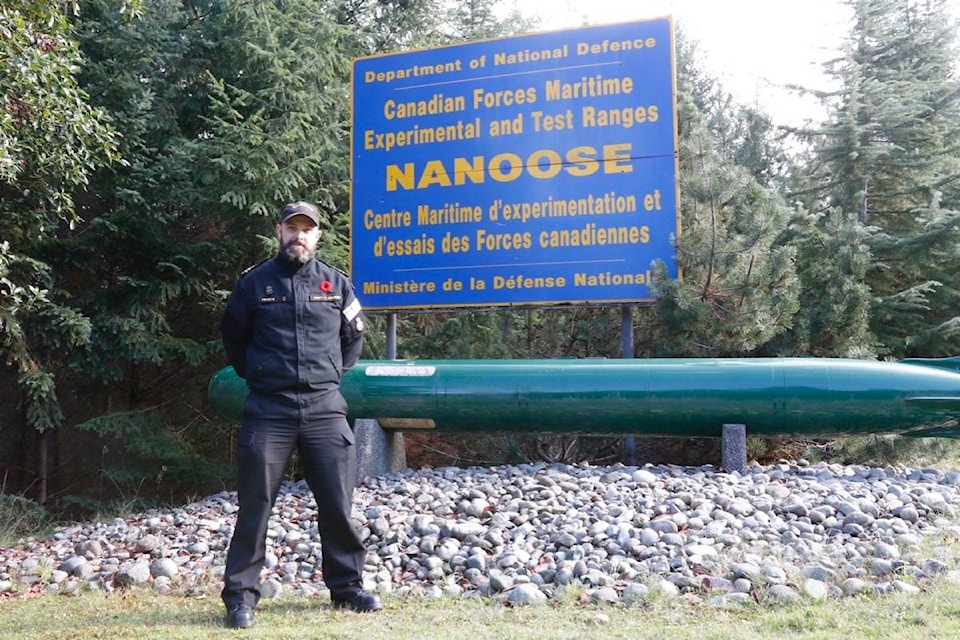When Lt. (Navy) Morgan Francis went to Remembrance Day ceremonies as a kid and thought about the sacrifices people had made, he imagined a certain type of person.
His grandfather having been a Navy pilot in the ’50s and ’60s, “tales of daring-do” and pictures of him no doubt coloured Francis’ idea of what sort of people were in the military.
“(Joining the military) was something that I didn’t necessarily aspire to when I was younger, but when I could think about what I thought was the coolest thing, there was always that picture of my grandfather in his Naval uniform.”
But, when Francis eventually decided to join the Navy at 26, he questioned whether he fit the bill: was he the kind of person that could be a member of the military?
“What you come to realize is that the Canadian Armed Forces is full of Canadians,” said Francis. “It’s full of people that you know, and really most armed forces members are no different than the rest of the people that live in your neighbourhood.
“Canadians are Canadians no matter if they’re in uniform or not, and I think that really, that was almost surprising to me.”
So, when members of the Canadian Armed Forces put themselves in harms way (as they continue to do, whether in war or not), it’s everyday Canadians who are making that choice.
Francis, for instance, took part in Operation CARIBBE, a drug-interdiction operation in the Caribbean in co-operation with the U.S. Coast Guard. Francis had earned his Bridge-Watch-keeping certificate, which meant that, at times when the captain wasn’t on the bridge, he was in charge.
“It means you’re driving,” said Francis. As a Naval Warfare Officer, getting that certificate is the first major hurdle to pass, but it’s nonetheless an intimidating and amazing responsibility, he said.
“It’s very scary at first, to be honest,” he said. “You’re launching helicopters and you’re recovering boats.”
“It’s a lot of responsibility and a lot of pressure to do the right thing and to make the right move. And as you get better at that responsibility, I don’t think there is anything cooler. You’ve got a very powerful, very fast warship at your control, and your whole job is to come up with a plan and if it’s a good enough plan, the captain will say ‘Yes, please,’ and you can really get going.”
Francis’s longest deployment was during Operation REASSURANCE, part of the NATO maritime group meant to show the world that it could put a strong fleet to sea. Francis sailed across the Atlantic Ocean, through the Mediterranean Sea and up to the Black Sea where a couple of Russian ships were in wait to escort them throughout their stay.
“This was in the wake of the Crimea annexation and so there was a lot of tension in that region, and there was a lot of people that were unsure of what their future holds,” Francis said. “The whole point of the operation was to reassure them… that we were supporting (them).”
“It felt good,” he said, “and it felt like we were doing something.”
During that time, Francis was the Deck and Naval Boarding Party Officer, meaning that he trained to board ships of groups potentially hostile to NATO, to himself and the people he led.
Francis trained to board ships from a helicopter and via rigid-hulled inflatable boat, working to the point where he felt ready to do the job if it needed to be done. Not just being able to do the job, but to do it professionally was stressed, he said.
Asked about the danger inherent in these operations, Francis said it was a hard question to answer.
“I don’t know if I’d call it safe,” he said of Op. REASSURANCE. “On one level, you’re sailing with an immensely powerful fleet,” he said, which included warships from Germany, Turkey, the United States, Spain and France.
Nonetheless, he said, “There’s always some level of danger when you’re off on the other side of the world and there’s certainly some people that are probably not all that thrilled to see you there, but there were a lot of people that were thrilled to see us there.”
Now, Francis is working at the Canadian Forces Maritime Experimental and Test Ranges (CFMETR) in Nanoose Bay, where he grew up. He gets to stop by at his parents’ house each day for tea, and be with his wife and children.
It’s great to be back home and with his family, he said, but he’ll get called back out to sea sooner rather than later.
With Remembrance Day coming up, Francis said he had a message:
“What I want people to know is that… it’s so important to remember the sacrifices that have been made in the past — the First and Second World Wars and Korea and any number of conflicts that Canadians have been involved in and died in… but also, you want them to remember that their Canadian Armed Forces are out there every day and they are Canadians that are just like you and me.”
“There are people that, as we speak, are away from their families in challenging situations and they are doing it… not just for this country as a nebulous ideal, but for the people of this country.”
“Remember that it’s not all in the past. It continues on every day.”
